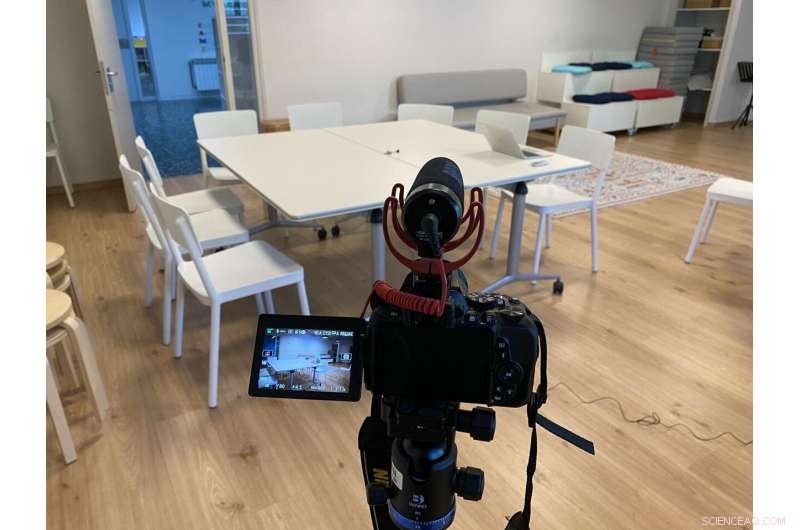
La ciencia nos dice que aprendemos mejor y más colaborando, y por tanto el espacio debe favorecer esto. Crédito:Smartclassroomproject.com
La imagen de filas de sillas y escritorios frente a un maestro en una pizarra ha sido una realidad durante décadas. Sin embargo, La investigación revela que esta forma de organizar el mobiliario de las aulas en las escuelas no es la mejor manera de favorecer el proceso de aprendizaje. Especialmente si se tienen en cuenta las necesidades de los estudiantes del siglo XXI, OMS, según la OCDE, requieren un entorno social que fomente la autonomía, flexibilidad, la capacidad de decisión y la conexión de conocimientos por parte de estudiantes individuales o mediante el trabajo en equipo.
También es la opinión de 6 de cada 10 profesores que cambiar el diseño del aula es clave para mejorar el aprendizaje. Este fue el resultado de un estudio reciente realizado por investigadores de la Universitat Oberta de Catalunya (UOC), Universitat Autònoma de Barcelona (UAB), Universitat de Barcelona (UB), Universitat de Vic (UVic) y Universidad Simón Bolívar (USB), en los cuales 847 preescolares, Participaron profesores de primaria y secundaria de 40 escuelas. “Asumimos que así deben ser los espacios sin pensarlo mucho o sin conectar lo que estamos innovando en términos de metodología con el lugar en el que lo vamos a poner en práctica, "dijo Guillermo Bautista, miembro del grupo de investigación Smart Classroom Project de la UOC e investigador principal de este estudio. Por eso necesitamos hacer realidad el Smart Learning Space:"un espacio que satisfaga cualquier necesidad o propuesta de aprendizaje, que sea flexible y no zonificado, en el que se prioriza el bienestar físico y psicológico como base sobre la que puede desarrollarse la actividad de aprendizaje, en el que los alumnos desempeñan un papel proactivo y autónomo, "dijo Bautista.
Varios estudios ya han reconocido los beneficios de un aula adecuadamente diseñada. Este fue uno de los motivos por los que el Consorci d'Educació de Barcelona empezó a sustituir el mobiliario de 487 aulas hace unas semanas, al mismo tiempo que se reorganizan los espacios para obtener entornos motivadores que fomenten el descubrimiento. Y, como señalan los autores del estudio liderado por la UOC, es que las habilidades y necesidades de aprendizaje de los alumnos de hoy no solo nos obligan a repensar nuestras prácticas docentes o la inclusión de recursos digitales, también requieren cambios en los espacios de aprendizaje en general.
Guillermo Bautista lo demuestra con un ejemplo:como él explica, la ciencia nos dice que aprendemos mejor y más colaborando, y por tanto el espacio debe favorecer esta colaboración e interacción, también teniendo en cuenta lo que nos dicen las investigaciones sobre el aprendizaje colaborativo. Si organizamos la actividad con grupos de cuatro alumnos en función de un desafío o un proyecto, Sería lógico que el espacio sea adecuado para permitir la colaboración del grupo y también para permitir cierta autonomía para el uso de los recursos que necesita. para moverse, mirando al rededor, experimentando y autoorganizado, etc. "Esto significa que no todos los grupos harán lo mismo al mismo tiempo, y los mismos recursos no serán necesarios para todos. La actividad en el aula es diversa y el espacio debe responder constantemente a esta diversidad organizativa de uso, recursos, movimientos " él explicó.
Sin embargo, la fuerte suposición sostenida durante décadas de que el aula es como es, has resulted in us proposing few changes. And when these are finally being proposed, the direction of these changes is not easy to decide upon, "and that is why our research is necessary, to help establish criteria so that the space is changed with guarantees, " él dijo.
Changes in the design of secondary school classrooms also
En la actualidad, most teachers negatively rate the organization of the environment in their classroom. This is one of the findings of the study, whereby low or moderate scores were obtained regarding the suitability of current classrooms to serve as comprehensive learning spaces. But differences exist between the different levels of education, as the design of preschool and primary education learning spaces is generally more flexible, collaborative and personal, affirm the authors of the study, who point to a possible reason for this scenario. "It is precisely in the infant and primary stages where teaching trends such as those applied since the early 20th century (in which the spaces, their layout, muebles, etc. were already linked to clear educational meanings) have been most present and usually more visible, " said Angelina Sánchez-Martí, researcher of the Smart Classroom Project and Serra Húnter professor at the Universitat Autònoma de Barcelona.
Por otra parte, the traditional layout of the spaces is much more established among secondary school centers and teachers. That's why the authors of the study positively value the fact that during the study it was confirmed that there are teachers and centers from this stage of education who are aware that their spaces do not correspond with the methodologies that they want to implement. "The Smart Spaces that we have implemented as part of the research are co-designed, applying a thoroughness, rigorousness, and seeking to meet the highest objectives and results for learning proposed by each center. And these spaces are needed in all of the stages, " said Bautista.
Another result to highlight is that the teachers are especially critical when it comes to appraising the integration of technology in the classrooms. But in the opinion of the authors of the study, this data is not surprising as "it is precisely the new technologies that are threatening the traditional times and spaces, and therefore demand great flexibility and a constant adaptation to change, as well as a reformulation of the learning spaces", said Sánchez-Martí. She added that the possibilities that technological integration offers in terms of creating new ways to relate and learn "completely clashes with the very standardized design derived from the idea that schools must be based on classrooms per se, when this does not necessarily have to be the case."